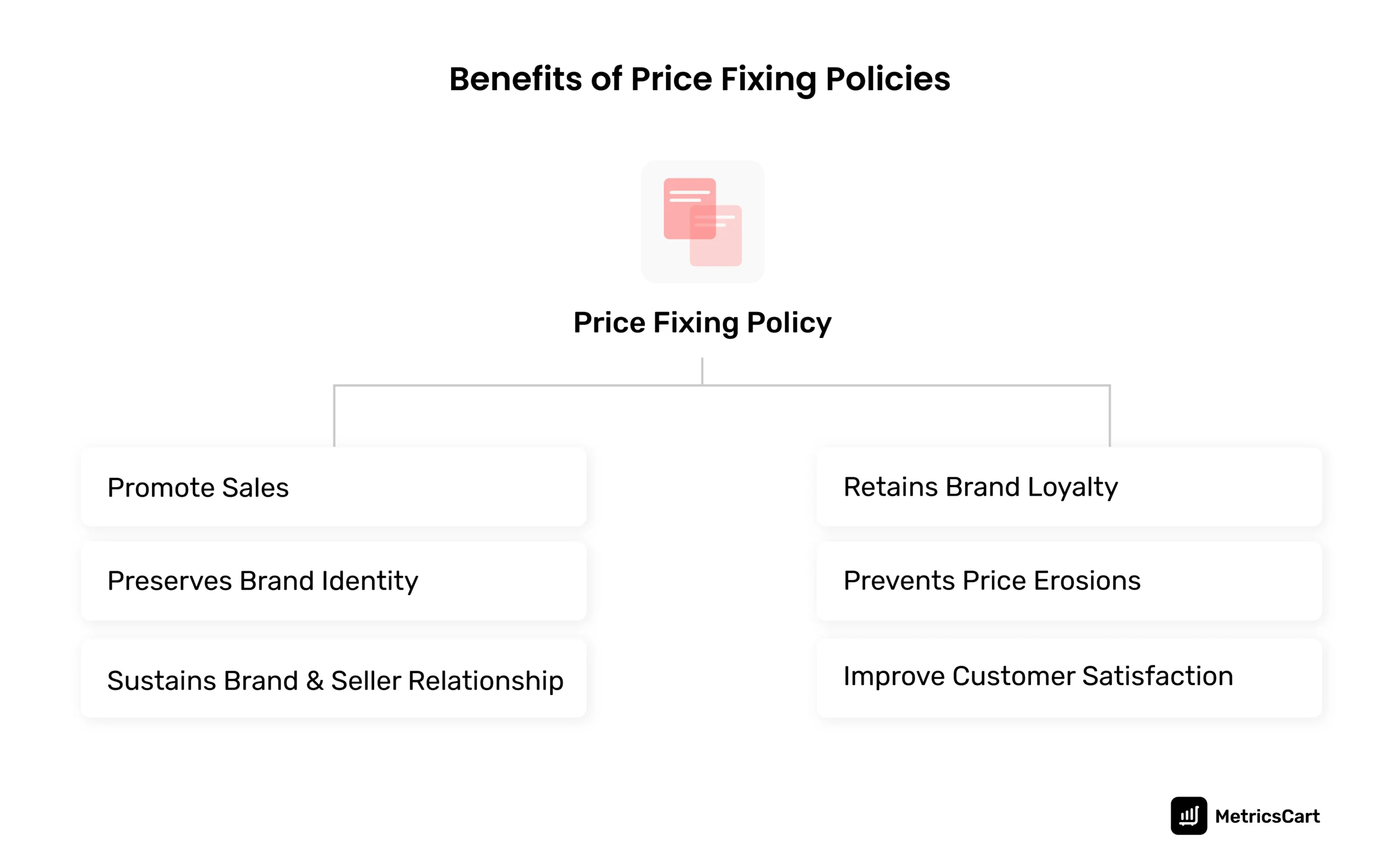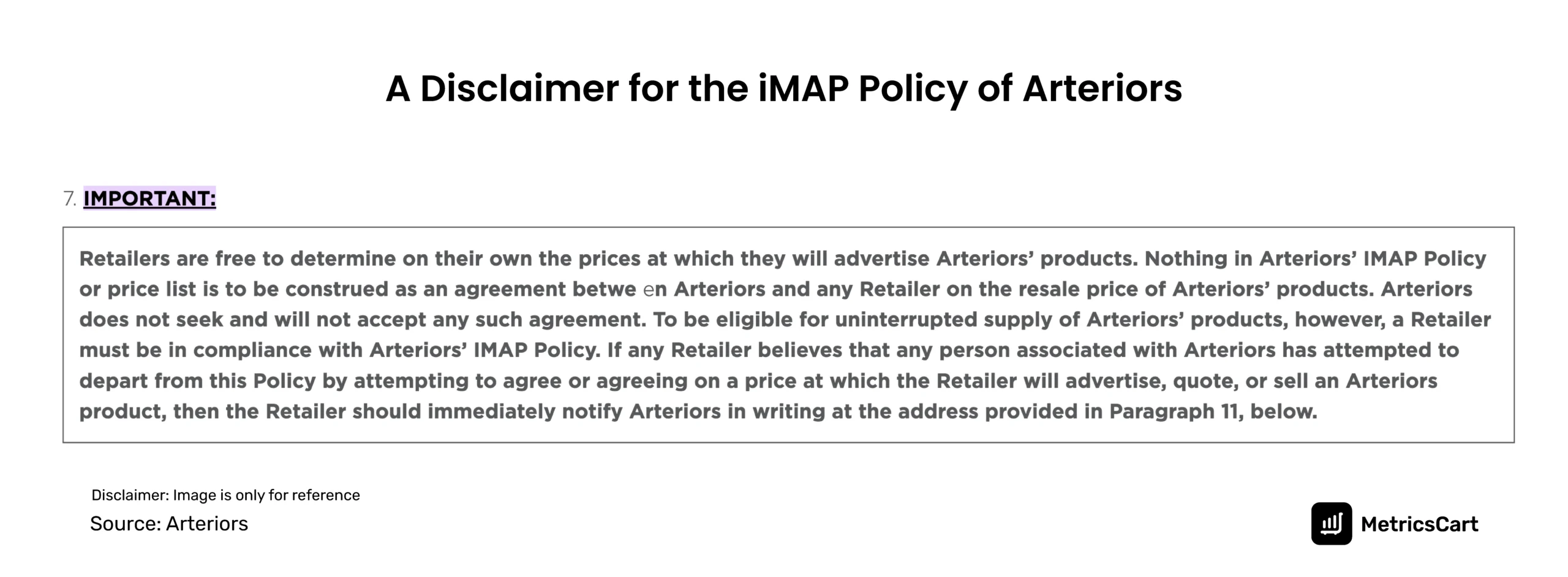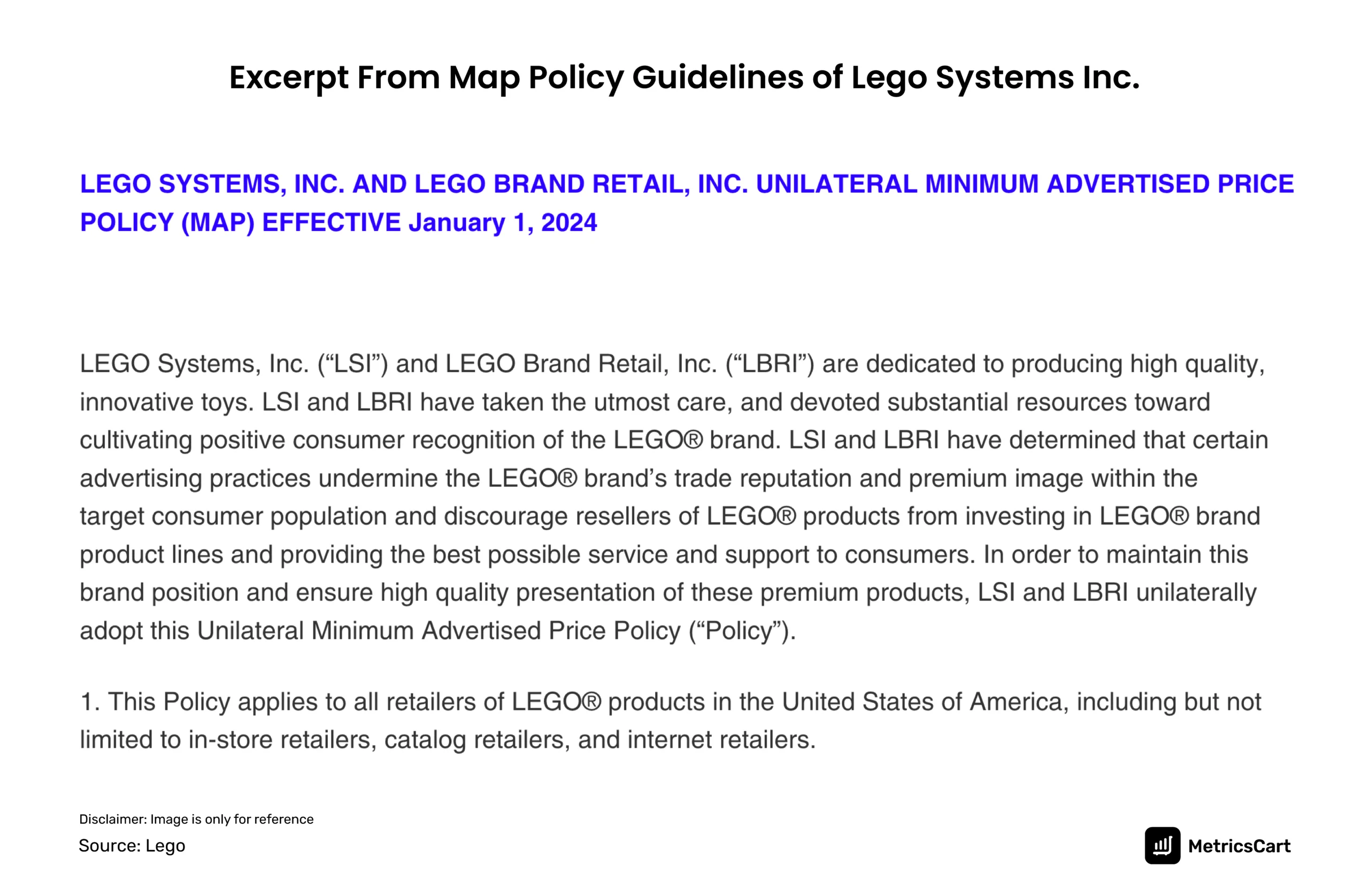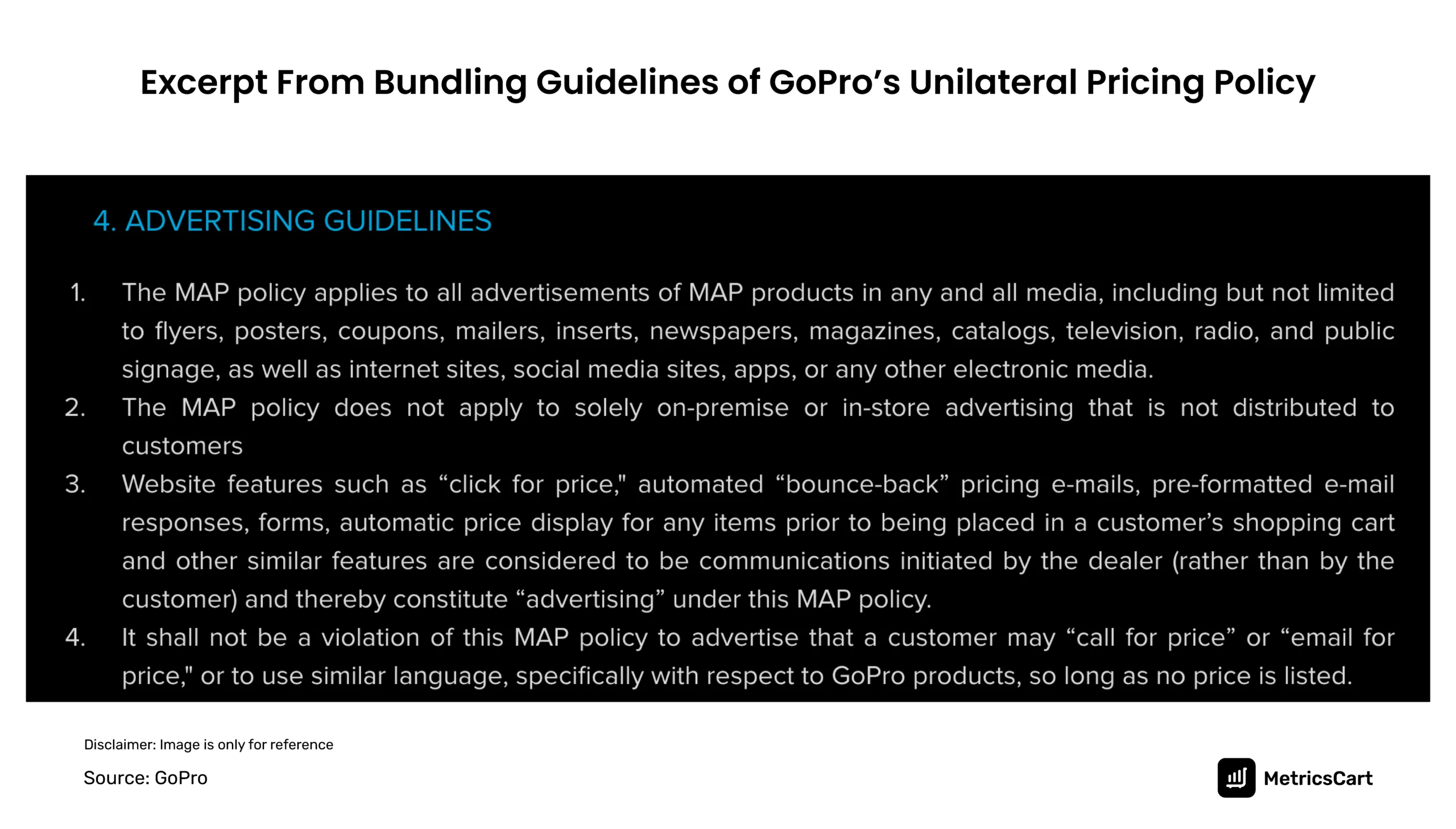Being a liberal market economy, the US is known for its business-friendly and decentralized structure, which does not impose many restrictions that stifle profit and competition. This spirit of having a liberal approach to the market has been emphasized in the Sherman Antitrust Act of 1890.
According to Britannica, the Sherman Act was created to gauge unwanted interference with market forces to curb competition and reduce trade performance. Under this, any form of price fixing policies were treated with suspicion, and brand policies requiring sellers to get into an agreement by controlling prices were considered illegal.
- Importance of Price Fixing in E-Commerce
- What Is Vertical Price Fixing: Types, Concerns & Clarifications
- Price Fixing Policies: What Brands and Sellers Need To Know
- Types of Common Price Fixing Policies
- Alternative to Resale Price Maintenance
- Conclusion: Getting to the Bottom of the Problem
- MetricsCart: Fortify Your Pricing Policies
Importance of Price Fixing in E-Commerce
Price fixing or price restraints are considered malpractices under the antitrust law, which could call for legal actions against the brand or manufacturer. However, not all price-fixing methods were considered bad for business.
The question is to what extent can a pricing policy interfere with the pricing choices of the seller so that it won’t cause any economic restraints. The line between an inclusive price-fixing policy and a predatory one can be very thin as it depends on multiple factors and choices taken by the manufacturers and sellers.

If implemented properly, price fixing can:
- Be a positive anchor point in promoting sales
- Create a consistent brand identity
- Stabilize the relationship between a brand and a seller
- Improve consumer satisfaction and brand loyalty
- Restrict price erosion and undercutting
According to implementation, price fixing methods are divided into horizontal and vertical. In horizontal price fixing, brands enter into an agreement with competitors to fix the price of their products. This happens without the knowledge of the consumer and hampers fair trade in the market. As this price-fixing happens between competitors, it is termed horizontal price fixing.
What Is Vertical Price Fixing: Types, Concerns & Clarifications
In vertical price fixing, supply chain participants like manufacturers, wholesalers, retailers, 3P sellers, etc., decide to lower, raise, or stabilize the price of products. Since it happens in a vertical structure, it’s called vertical price fixing.
Is Vertical Price Fixing Illegal?
If the price-fixing decision is made by consulting sellers or through any form of agreement, then it becomes illegal under the US antitrust law. Price-fixing lawsuits are considered on a case-by-case basis by the court of law as they can have both pro-competitive and anti-competitive effects in the market.
Types of Vertical Pricing
Vertical price fixing is divided into two types:
- Vertical Minimum Price Fixing
- Vertical Maximum Price Fixing
The US manufacturers mostly follow vertical minimum price fixing methods like MAP pricing, MRP, etc., of their own accord. Any kind of mutual agreement will be treated as unlawful as it can create unwanted market outcomes like high prices, low-quality consumer service, etc.
Does Vertical Price Fixing Affect E-Commerce Business?
Price fixing policies are always a roadblock for online sellers as they restrict them from selling a product below or above a certain price threshold. Such restrictions can hinder the entrepreneurial goals of online retailers and sellers.
Some of the major concerns about price-fixing policies are:
Price Flexibility Takes a Hit
Every online seller or retailer wants to sell more products than their competitors to profit from their business. This is done by employing different pricing strategies according to the demand in the market. When brands create a price-fixing policy, the freedom of the seller to decide prices becomes restricted.
Profit Margins Gets Minimized
When retailers or 3P sellers can sell their products only at a certain price range, the profit margins also get reduced comparatively. This can become a long-term issue for small-scale sellers operating on less profit margins.
Hard To Stand out of the Crowd
Employing multiple pricing and promotional strategies like seasonal discounts, flash sales, limited deals, etc., helps a 3P seller stand out from the competition. This gets affected as a price-fixing policy regulates the pricing range of a product with a minimum advertisable/resale price.
Risk of Losing Credibility
If a price-fixing policy is not implemented with careful attention and legal advice, then it will invite antitrust cases that can tarnish the reputation of the brand. However, for a retailer or online seller, this can escalate their litigation expenses and create unwarranted complications in the supply chain system.
Price Fixing Policies: What Brands and Sellers Need To Know
It is an obervable fact that all price changes or similarities are not due to price fixing. These can be the result of retailer choices with regard to shifting market dynamics. Prices of cereal products like corn, wheat, etc., can be similar in most shops because they are affected by the fluctuating prices charged by the farmers.
However, different retailers and sellers can offer other products in the CPG category at highly competitive prices. As these products are consumed on a daily basis, the demand for them also increases.
Types of Common Price Fixing Policies
According to the popular market perspective, some of the common price-fixing policies employed by brands are:
Resale Price Maintenance (RPM)
RPM aims to create a fixed pricing guideline for sellers and retailers. They can include minimum or maximum prices for products. An RPM mostly consists of agreement-based policies that have a high risk of anti-trust lawsuits.
Minimum Advertised Price (MAP)
MAP policy defines the minimum price of a product that can be advertised on any platform by a 3P seller or retailer. They can choose to sell the product at the price of their choice, but the advertised price shouldn’t be less than MAP.
Internet Minimum Advertised Price (iMAP)
iMAP is the minimum advertised price the seller displays on any online platform like Amazon, Walmart, etc. It creates a crucial guideline for online retailers who employ dynamic pricing strategies in their business.
Electronic Minimum Advertised Price (eMAP)
eMAP follows any form of the minimum advertised price displayed or aired through multiple electronic media like public broadcast systems, television, mobile SMS marketing, etc.
Minimum Resale Price (MRP)
In the US, there are brands that set a minimum resale price for a product and it restricts the seller from pricing a product below the MRP. This is also considered a violation of the Sherman Act if the brand enters into an agreement with the seller or retailer.
Alternative to Resale Price Maintenance
Because of the lawsuits attracted by RPM and other bilateral policies, manufacturers are implementing one-way pricing policies called the Unilateral Pricing Policy. These are created by the brand or manufacturer at their own discretion without any negotiation or consultation with competitors or sellers.
Unilateral Pricing Policy (UPP)
The Unilateral Pricing Policy is also known as Colgate Policy as it was first introduced by Colgate in the famous court case of 1919.
 As this is a one-way document created by the brand, sellers can choose not to abide by the policy guidelines. This can invite enforcement measures from the manufacturer’s side which would mostly include cancellation of further services, suspending dealer’s account, etc.
As this is a one-way document created by the brand, sellers can choose not to abide by the policy guidelines. This can invite enforcement measures from the manufacturer’s side which would mostly include cancellation of further services, suspending dealer’s account, etc.
Unilateral MAP (UMAP)
UMAP is a traditional MAP policy but executed as a unilateral document. This enables the brands to stay out of any legal complications arising out of MAP enforcement.
 UMAP policies are a sub-set of UPP and brands monitor violations in UMAP using price intelligence solutions like MetricsCart.
UMAP policies are a sub-set of UPP and brands monitor violations in UMAP using price intelligence solutions like MetricsCart.
Manufacturer’s Suggested Resale Price (MSRP)
Also known as Recommended Resale Price (RRP), MSRP is considered one of the safest price-fixing strategies for brands. MSRP is used in the unilateral pricing policies of brands to suggest a resale price to the seller or retailer.
Enforcing MSRP can:
- Help brand positioning
- Sustain profit margins
- Prevent price wars

Manufacturers also keep an eye on the promotional strategies of retailers or sellers. Specific guidelines are released in the UPP for promotional strategies like bundle pricing, discounts, gift cards, etc. Compliance with these guidelines is expected from the sellers.
READ MORE | Is there a difference between MAP and MSRP? Check our whole read on MSRP vs. MAP: Understanding Retail Price Terminologies
Conclusion: Getting to the Bottom of the Problem
To conclude, it is important to acknowledge that price fixing policies and their implementation in any kind of business, online or physical store, requires careful consideration and a transparent legal recourse. They are not created as black-and-white documents with clear definitions or solutions.
The fundamental concern of vertical price fixing policy is how it is implemented between a brand and a seller.
Conventionally, the RPM agreements were treated as illegal until 2007, after which the Supreme Court ruled that RPM can’t be deemed illegal if a Rule of Reason is established. That is if the brand or manufacturer is able to convince the court that the vertical price fixing policy they created works positively toward trade and creates a pro-competitive environment.
One of the acceptable alternatives to RPM is UPP, where a unilateral policy is set by the manufacturer recommending the minimum resale price and advertised price.
These are not agreements or contracts and, hence, cannot be under the purview of antitrust laws.
MetricsCart: Fortify Your Pricing Policies
Understanding and implementing price-fixing policies is just one part of the game. Monitoring your MAP and product prices is crucial for the growth of your online business. Brands need to be one step ahead of the game by choosing the right price intelligence solution that can keep up with the dynamic requirements of the online platform.
MetricsCart offers advanced MAP monitoring analytics for your business, so you don’t miss any important updates. Get on a discovery call with us and increase your scalability factor 4x.





